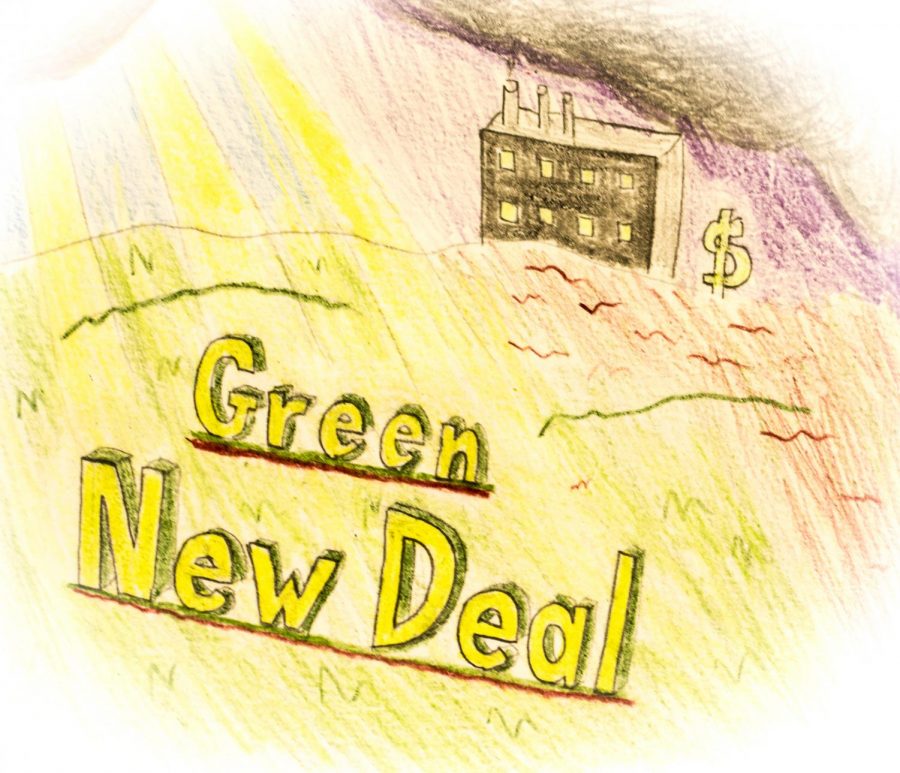Green but Going Nowhere
The Green New Deal is idealistic but hardly practical
February 27, 2019
If one were to look at all of the news from the past few weeks, it would be nearly impossible to miss something about the “Green New Deal,” a goliath of a resolution sponsored by Rep. Alexandria Ocasio-Cortez (D-N.Y.) and Sen. Edward Markey (D-Mass.) aimed at addressing climate change. The official resolution was accompanied by a FAQ released by Ocasio-Cortez’s office to their website and to media outlets.
The resolution aims to achieve net zero greenhouse gas emissions in ten years, a slightly less ambitious goal than completely eliminating emissions due to our ability to siphon small amounts of carbon dioxide out of the atmosphere manually.
The overall premise of the Green New Deal is correct; according to a report from October by the Intergovernmental Panel on Climate Change, global carbon-dioxide emissions must reach net zero by 2050 to limit temperatures from rising more than 1.5 degrees Celsius. Increases beyond that are projected to lead to extreme weather. Because a private market economic system provides no incentive to reduce carbon emissions, government intervention would be necessary to achieve this goal.
However, the sheer cost and practicality of the goals outlined in the resolution render the economics of the Green New Deal unrealistic.
The resolution hopes to meet “100 percent of the power demand in the United States through clean, renewable, and zero-emission energy sources.” Not much other information regarding electricity is found in the resolution, but it is obvious that to meet this goal the energy industry would have to turn to renewable sources like solar and wind energy. According to the U.S. Energy Information Administration, renewable energy sources powered just 11% of the country in 2017 despite large federal and state subsidies. While wind and solar energy have improved in cost and efficiency over the past ten years, neither provides a reliable, constant stream of power; as a result, backup plants that burn fossil fuels are still necessary to fill in the gaps. A commonly proposed solution is to store energy in batteries; this cheap battery storage does not yet exist, however, and would require technological advances.
The bottom line is that significantly eliminating greenhouse gas emissions in the energy industry may not be technologically feasible within the next ten years.
The transportation industry now produces more greenhouse gases than power generation, according to the US Environmental Protection Agency’s statistics. To reach net zero emissions, the US would somehow have to eliminate greenhouse gas from both vehicles and manufacturing. The FAQ published by Ocasio-Cortez’s office states that “we aren’t sure that we’ll be able to fully get rid of farting cows and airplanes that fast,” leading to controversy over whether the Green New Deal calls for the elimination of air travel and the consumption of cow meat. In terms of agriculture, methane gas contributes a significant portion of emissions to the agricultural sector. A blog post from Ocasio-Cortez’s website contained the same quote from the FAQ, though it omitted the word “farting”. Critics of the Green New Deal have concluded that the resolution thus intends to eliminate cows, including dairy and meat, from the American diet, though this language never strictly appears in the official resolution itself.
The US produces approximately 15% of global carbon-dioxide emissions. However, China emits more CO2 than the US and the EU combined. The harm from climate change is a result of global emissions, and even if net zero emissions in the US are achieved, they will most likely only marginally benefit Americans unless other countries like China and India do the same.
However, the unrealistic physical and technological practicality of the Green New Deal is not the only obstacle it faces. The resolution calls for greater government involvement in housing, education, and many other sectors of the economy as well as the elimination of private health care. A quote from the FAQ heavily criticized by opponents includes a provision of economic security for those “unwilling to work.” The chances of the majority of these aspects of the resolution being passed into actual governmental policy over the next few years are slim to none, especially given the current sociopolitical conflict of ideals within government.
While the Green New Deal and its aspirations on a ten year deadline are not practical both physically and politically, they move the environmental cause to the forefront of discussion and highlight an issue that needs to be given greater attention. The Green New Deal is much more of an ideological phenomenon than actual policy guidelines. Some ideals of the resolution are absolutely correct, but the vague solutions to problems presented throughout the document make it too unrealistic to be considered a true solution.













